17 Easter Food Traditions From Around the World
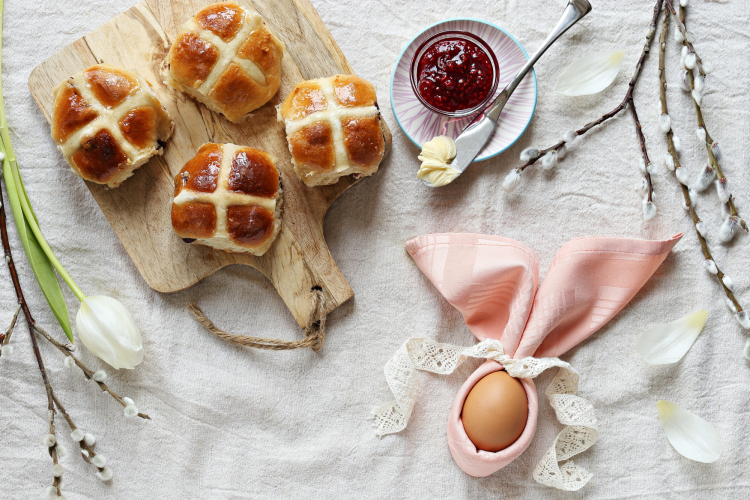
A holy time in countries throughout the world, Easter is a deeply meaningful holiday to those who observe it, with Easter food traditions being just as steeped in symbolism and reverence as the religious and cultural events that denote the season.
In Christian tradition, Easter is the holiest of celebrations commemorating the resurrection of Jesus. As noted in Britannica, the symbolism of rebirth and renewal, dating back to Pagan festivals honoring the spring, became inextricably linked to the way the Easter holiday is observed today.
These days, food still plays a major role in the holiday, with Easter feasts comprising dishes steeped in history and significance, as well as those that are more modern. You'll also find that what makes up a traditional Easter dinner varies from continent to continent and country to country.
So, what do people eat on Easter across the world? Traditional Easter foods are as diverse and abundant as the bounty of spring, with countries around the globe sharing symbolic staples while also offering unique contributions to the Easter feast.
To find out more about this interesting topic, let’s explore 17 Easter food traditions from around the world!
Jump to Section
17 Easter Food Traditions From Around the World
1. Eggs
One of the most recognized Easter symbols is the egg. Easter food traditions around the world celebrate this emblem of life and rebirth.
In fact, as Britannica explains, eggs and Easter have been connected since at least the Middle Ages, when those who attended Eastern Orthodox and Western churches would dye eggs that chickens laid during Lent (which at that time could not be consumed).
From children hunting decorated hard-boiled or chocolate eggs in countries like the United States to making and eating stuffed eggs in Poland, the egg remains an integral part of Easter celebrations around the world.
Additionally, eggs turn up as both an ingredient and decoration for many seasonal treats. For example, eggs are used as an ingredient in dishes like fanesca and torta pasqualina featured later in this guide of classic Easter foods. You will likely see sweets like sugar cookies decorated as Easter eggs as well.

2. Lamb
Another symbol widely associated with Easter food traditions is the lamb, which has roots in Paganism, Judaism and Christianity. Lambs are an important part of the Easter tradition, from the sacrificial lamb of the first Passover to Jesus being referred to as the Lamb of God. Lambs also symbolize spring and new life.
Eating lamb on Easter is popular in the U.S. and throughout Europe, such as roast lamb in the U.K. and Greece. Another variation of this typical Easter foodis the French gigot d’agneau pascal, a rich, slow-cooked lamb stew often served with spring vegetables.
Lamb can even be found throughout the holiday feast in the form of butter or cheese molded into the shape of the animal or appearing on adorable cakes and desserts. This symbolism of the animal also extends beyond food to other Easter traditions, such as being featured on greeting cards given for the holiday.
Lamb Recipes To Try
Side Dishes for Lamb
3. Ham
Although Easter food traditions in America have been heavily influenced by the customary dishes brought by immigrants from Europe, glazed ham is a popular centerpiece of the American Easter table that is not as common in other parts of the world.
Now that we have given one answer to "what do Americans eat on Easter?", let's answer the question: "Why do people eat ham on Easter?"
Well, with hogs traditionally being slaughtered in the winter, the meat historically could not be consumed right away. Therefore, it was salted and cured to be ready in the spring, making it a cheaper and more accessible option than lamb for Easter feasts.
Pigs are also associated with good luck and prosperity and are eaten in the hope of a prosperous planting season and harvest.
Even though some of these reasons and meanings for eating ham on Easter Sunday may not remain, ham is still a centerpiece of choice for a traditional Easter dinner in the U.S.
Side Dishes for Ham

4. Enriched Breads
As a staple of Easter food traditions, enriched breads are found in celebrations across Europe and Russia, but will often be served in other countries around the globe as well. Enhanced with eggs, butter and milk, plus fruits, nuts or cheeses, these special breads go by many names.
Colomba pasquale (or colomba di Pasqua), a sweet bread studded with candied orange peel and shaped like a dove, is a traditional Italian Easter food. Paska is an Eastern European egg bread, while Bulgarians celebrate with kozunak, a sweetened yeast bread that is often braided and embellished with raisins and sliced almonds.
Lithuanians enjoy a similar semi-sweet bread called velykos pyragas, Polish feasts include a golden loaf of chałka and the Greeks bake a soft, spiced tsoureki traditionally made with three braids to represent the Holy Trinity.
Hot cross buns, which we cover in more detail next in this guide to Easter food traditions, also fall into this category.
5. Hot Cross Buns
Bread is perhaps the most important item on the Easter table and appears in nearly every cuisine. Bread represents life and is deeply connected to the Christian faith through practices such as communion.
Just as Christianity traveled across the world largely due to British colonizers and missionaries, the hot cross bun has become a ubiquitous Easter food tradition.
A traditional Easter food in Ireland and the United Kingdom, as well as Australia, New Zealand, Canada and the Caribbean, the hot cross bun is a soft, spiced roll made with dried fruit and marked with an icing or dough cross.
The buns are traditionally eaten on Good Friday to commemorate the crucifixion, and according to the Smithsonian, have a rich history, with many meanings associated with them.
Whether you buy some or bake them yourself, they're a delicious and comforting Easter food to indulge in. A boxed-up bunch of hot cross buns would also make a lovely Easter gift!
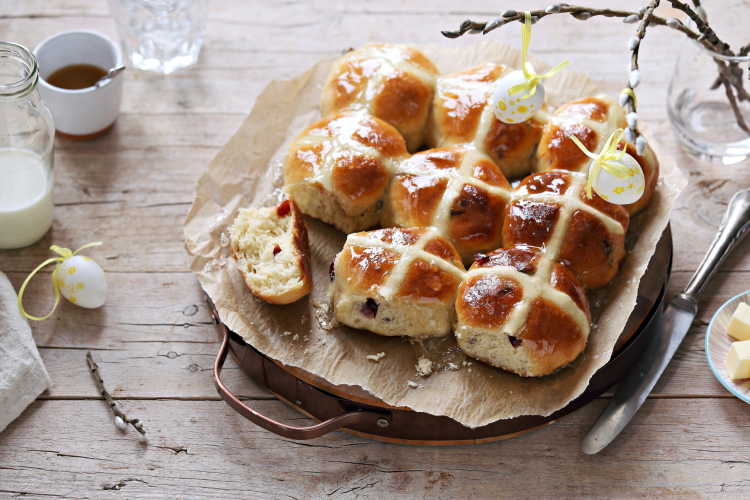
6. Bun and Cheese, Jamaica and the Caribbean
Most often believed to be a descendant of the hot cross bun, eating Jamaican buns and cheese is a popular Easter food tradition throughout the Caribbean.
Over time, the classic bun shape transformed into a small loaf, replacing the honey and fruit with molasses and spices, giving it a flavor distinct to the islands.
The loaf is commonly eaten with Jamaican “tin cheese” or pieces of sliced cheese.
7. East Indian Fugias, India
Another Easter food tradition comes from a country that might be surprising: India. Although not as prevalent as Hinduism and Islam, Christianity made its way to India along with the British, inspiring this unique dish enjoyed during the Easter festivities.
Fugias are fermented and deep-fried bread balls that look like tiny balloons. The time-intensive dish is generally reserved for special occasions and can be eaten alongside Indian food like curries or enjoyed on its own.
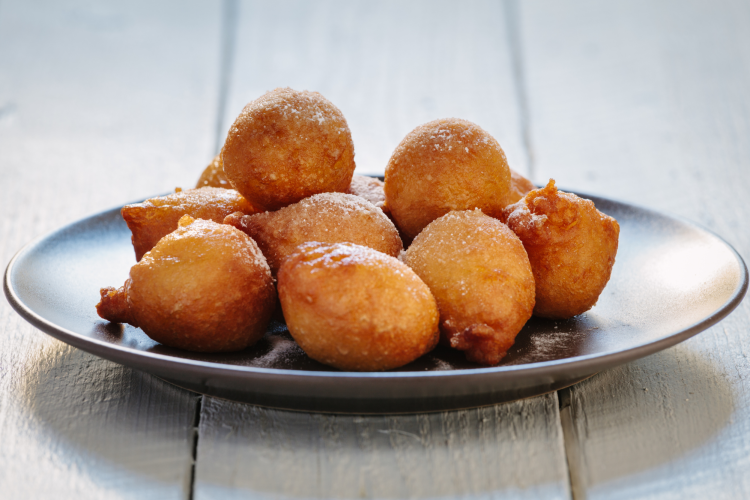
8. Difo Dabo, Ethiopia
Some might be surprised to learn that Ethiopia has one of the largest Christian populations in the world, with Easter being a most sacred holiday.
Following a rigorous Lenten fast that prohibits animal products, the holiday meal is an expansive spread featuring stewed meats including chicken, beef and lamb, along with beer and mead brewed for the occasion.
Accompanying the feast is difo dabo, a round wheat loaf enriched with milk and honey. Its name and ingredients are a reference to the Biblical promised land. Traditionally, the bread is wrapped in koba leaves and baked in a clay oven.
9. Torta Pasqualina and Torta Pascualina
Easter food traditions can be traced across the world, with similar dishes appearing in unexpected places. Torta pasqualina is an Easter pie popular throughout Italy, featuring a flaky crust filled with spinach, ricotta and most importantly, hard-boiled eggs.
This Easter food is a nearly identical pie found during Easter celebrations in Argentina and Uruguay. It was brought to South America by Italian immigrants in the early twentieth century and has now become a cultural staple.
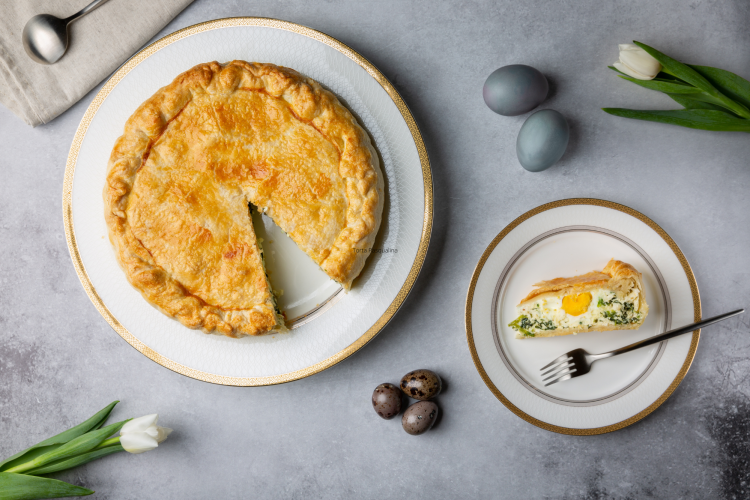
10. Figolli, Malta
Most likely due to the holiday happening at the end of a period of fasting for Lent, Easter food traditions are laden with decadent desserts, including buttery cookies, sweet breads and elaborate cakes.
In Malta, an island nation south of Sicily, the observance of Lent, Holy Week and Easter is filled with festivals, processions and symbolic foods.
After abstaining from sweets during Lent, Maltese children get to enjoy figolli, sweet almond cakes covered in icing or chocolate and shaped into traditional symbols such as fish or lambs.
11. Fanesca, Ecuador
Eating the dish fanesca is an Easter food tradition unique to Ecuador. It is an elaborate stew with an unusual combination of flavors. Unlike many dishes on this list, which are eaten on Easter or generally around the holiday, fanesca is a food eaten on Good Friday.
Believed by some to draw from traditions of the indigenous people of the Andes and Christianized with the arrival of the Spaniards, the creamy stew features 12 grains to represent the apostles and salt cod to signify Jesus.
The dish is often topped with peanuts, fried plantains, hard-boiled eggs and/or mini empanadas.

12. White Borscht and Żurek, Poland
On Easter morning in Poland and other Eastern European cultures, families attend church with baskets of food to be blessed during this holy time in hopes of a bountiful year ahead.
The baskets are rich with significance, each element carrying a unique connection to the holiday. Many also include ingredients to make traditional Easter foods.
These traditional Polish Easter foods include two popular soups, white borscht fermented with a wheat starter and żurek, which uses a rye starter. To these soups, Easter food basket ingredients like bacon, eggs, bread and/or sausage are added.
With this Easter custom and tradition from around the world, it's important that each member of the family eat a bite of the blessed foods as part of the Easter meal.
13. Pashka, Russia
This Russian Easter food tradition is so connected to the holiday that it shares its name. Pashka is a thick pudding in the shape of a truncated pyramid that represents the tomb of Christ with letters signifying the phrase “Christ is Risen” imprinted on its side.
This cheese-cake-like dessert is made with a special type of cheese curds with added raisins, fruit, jam or spices.
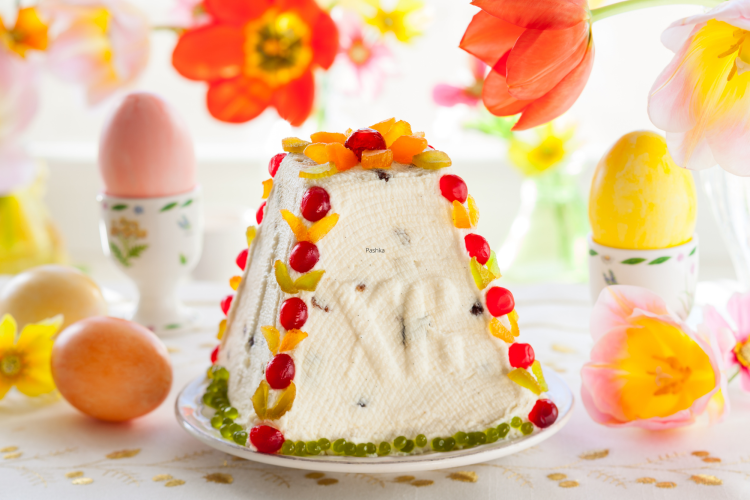
14. Mämmi, Finland
In addition to more familiar Easter candy and sweets, such as chocolate eggs, Easter food traditions in Finland often include a dish that some might consider an acquired taste.
Mämmi is a type of pudding made from water, rye flour, powdered milk, orange zest, salt and powdered rye malt or dark molasses.
It is traditionally left to sweeten naturally before being baked and chilled for a few days before it's eaten with milk. This dessert is believed to have been born out of necessity due to a lack of fresh produce and the restrictions of Lent, but continues to be served today due to being a much-loved Easter dish.
15. Capirotada, Mexico
Although perhaps not as popular as it once was, serving Mexican bread pudding (capirotada) is a long-standing Easter food tradition that is rife with symbolism. Each element of the dish represents an aspect of the crucifixion or resurrection.
Born from a merging of Aztec and Spanish ingredients, this unique dish forgoes the custard typical of a bread pudding and instead relies on salty cheese and clove- and cinnamon-spiked syrup for moisture and flavor. It's often topped with chopped nuts, colorful sprinkles and even cheese.
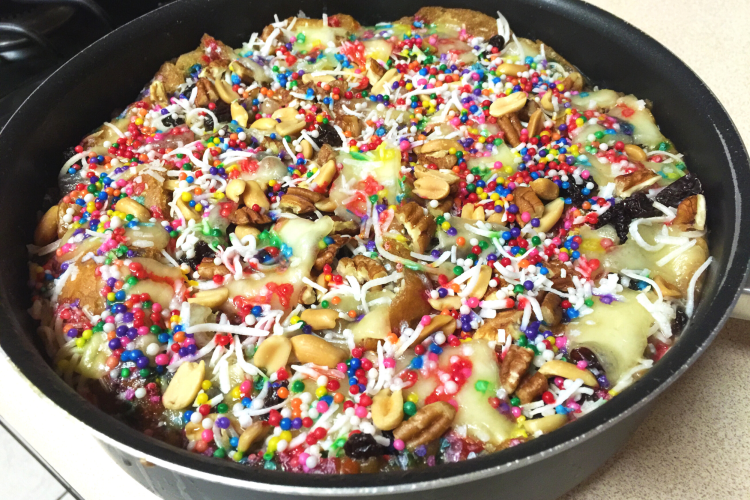
16. Kalitsounia, Greece
Easter celebrations in Greece are brimming with food and family. Tables overflow with spit-roasted lamb, traditional breads and of course, lots of sweets and pastries.
One of these pastries is Kalitsounia. While this pastry (which can be sweet or savory, but is often sweet for Easter meals) is popular throughout the country, it's especially so on the Greek island of Crete.
For the holidays, the pastry is filled with a mixture of soft cheese, orange peel and cinnamon, and is either baked or fried.
17. Simnel Cake, United Kingdom
Signalling the end of Lent in the United Kingdom is the flavorful and spiced simnel cake. It's an Easter food tradition to prepare this cake in advance of Easter Sunday when it is served.
The base is a spiced cake with dried fruit. This classic cake is then topped with a layer of marzipan (usually secured to the cake with jam, like apricot jam) and eleven marzipan balls to represent the apostles, minus Judas.

Celebrating Easter Food Traditions
Deciding what to eat on Easter and which Easter food traditions to incorporate into your celebration can be an overwhelming task!
Whether you want to find some more Easter dinner ideas from around the world or improve your technique in preparing traditional Easter dishes, cooking classes near you provide a fun and interactive way to do just that, allowing you to easily celebrate through food.
With these types of culinary experiences, you'll learn authentic recipes with the help of world-class chefs anywhere in the U.S., from cooking classes in Philadelphia to Denver and those even further afield. There are also many online cooking classes to take from the comfort of home.
For those looking to elevate their Easter dinner or Easter party food spread, hiring a private chef near you is a great way to reduce the stress of hosting. The chef handles everything, from shopping to cooking, serving and even cleanup.
If this sounds appealing, you can enjoy a gourmet Easter dinner prepared for you and your family, thanks to private chefs in Chicago, San Francisco and beyond.
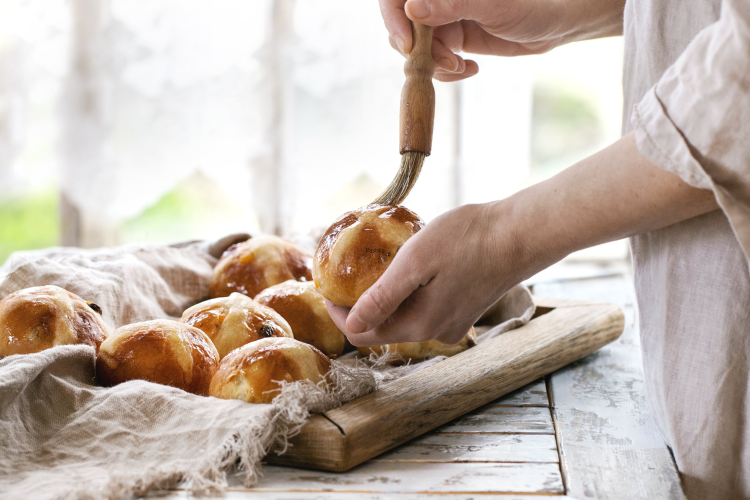
If you've ever wondered, "What do people eat on Easter in other countries?", this guide should have helped to give you some insight into that.
From dishes rich with symbolism to those created from a blending of cultures, Easter food traditions are a fascinating representation of the ingredients, culture and history of a region.
Having read this article, you should now be able to enhance your holiday feast by finding inspiration from Easter food traditions from around the world and exploring the deeper meaning behind the recipes that make up a traditional Easter dinner in countries near and far.
For even more fun ways to celebrate the holidays, check out other experiences happening on Cozymeal.

